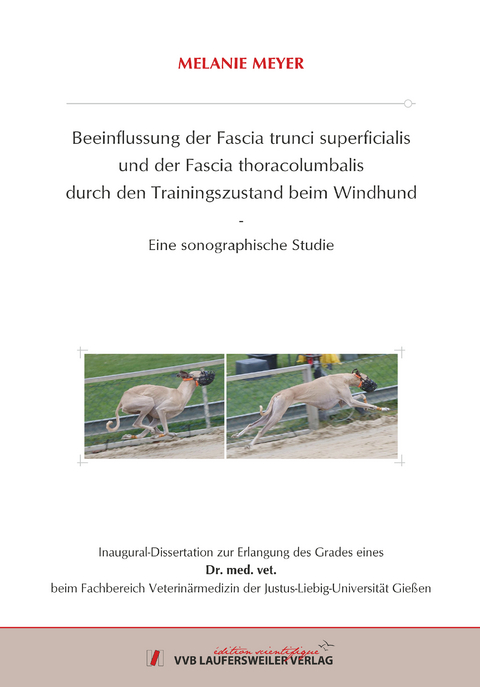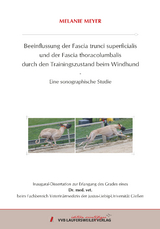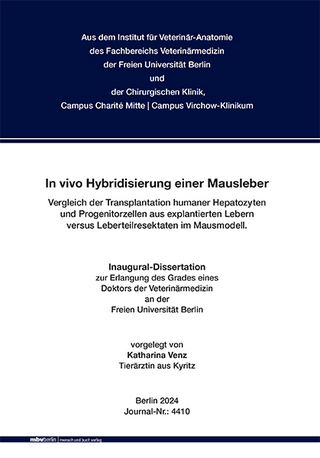Beeinflussung der Fascia trunci superficialis und der Fascia thoracolumbalis durch den Trainingszustand beim Windhund: Eine sonographische Studie
Seiten
2022
VVB Laufersweiler Verlag
978-3-8359-7043-4 (ISBN)
VVB Laufersweiler Verlag
978-3-8359-7043-4 (ISBN)
- Keine Verlagsinformationen verfügbar
- Artikel merken
Die Ziele dieser Arbeit sind die sonographische Darstellbarkeit und Beschreibung des caninen Fasziengewebes und eine klinische Dickenmessung der oberflächlichen Faszie (Fascia trunci superficialis) und der lumbalen Rückenfaszie (Fascia thoracolumbalis) des Windhundes im Rennsport.
Anhand der Teilstudie am Hundekadaver kann belegt werden, dass der Ultraschall auch beim Hund zur genauen Ansprache und Auswertung der Fasziendicke dienen kann.
Die Schichtdicke der oberflächlichen Faszie (Fascia trunci superficialis) und der Lumbalfaszie (Fascia thoracolumbalis mit Lamina superficialis/dorsalis) sowie die Gesamtdicke aus beiden Anteilen wird bei Sporthunden (Kohorte 1, n = 25) im Training und der Trainingspause sonographisch bilateral auf Höhe des 6. Lendenwirbels erfasst. Die Gruppe der Sporthunde wird anschließend mit einer Gruppe von Hobbywindhunden (Kohorte 2, n = 17) verglichen.
Die Lumbalfaszie (Fascia thoracolumbalis mit Lamina superficialis/dorsalis) der Kohorte 1 unterliegt einer sonographisch erfassbaren Veränderung der Dicke. Eine sportliche Nutzung der Windhundrasse führt zu einer signifikanten (p < 0,05) Abnahme der Dicke um 19 % von 0,95 mm auf 0,77 mm. Die oberflächliche Faszie (Fascia trunci superficialis) ist dünner als die Lamina superficialis/dorsalis und bleibt in ihrer Schichtdicke konstant (0,75 mm). Die Gesamtdicke (oberflächliche und tiefe Faszie mit tiefem Fettgewebe) aller Hunde der Kohorte 1 zeigt keine signifikante Veränderung. Die tiefe Fettschicht als Anteil der Gesamtdicke ist im Training 24 % dünner. Es besteht kein signifikanter Körperseiten- und Geschlechterunterschied.
Alle Faszienanteile der Kohorte 2 sind signifikant dicker als die „untrainierten“ der Kohorte 1: Die Fascia superficialis (1,34 mm) ist 43 % und die Lamina superficialis/dorsalis (1,33 mm) 27 % dicker. Die Gesamtdicke (oberflächliche und tiefe Faszie mit tiefem Fettgewebe) ist bei Kohorte 2 im Vergleich 26 % und davon die tiefe Fettschicht 7 % dicker. Es besteht kein signifikanter Körperseiten- und Geschlechterunterschied.
Eine sportliche Nutzung über die Alltagsbewegung hinaus scheint nicht nur temporär, sondern auch langfristig die Schichtdicke der Faszien zu beeinflussen und „dünne“ Faszien könnten als positive Körpereigenschaft bewertet werden.
Diese Arbeit stellt ein standardisiertes Messprotokoll der Dicke der Fascia thoracolumbalis im Querschnitt auf Höhe L6 des Windhundes im Ultraschall dar, welches als Vorlage bei aufbauenden Studien dienen könnte. The aims of this study are the sonographic representability and description of canine fascia tissue and a clinical measurement of thickness of the superficial fascia (Fascia trunci superficialis) and the lumbar fascia (Fascia thoracolumbalis) of sighthounds in sport.
Based on the sub-study on a dog carcass, it can be proven that ultrasound can also be used in dogs for the evaluation of fascial thickness.
The layer thickness of the superficial fascia (Fascia trunci superficialis) and the lumbar fascia (Fascia thoracolumbalis with Lamina superficialis/dorsalis) and the total thickness of both parts are measured by ultrasound bilaterally at the level of the 6th lumbar vertebra of sport dogs (group 1, n = 25) during training and training break. The group of sport dogs is compared with a group of hobby sighthounds (group 2, n = 17).
The lumbar fascia (Fascia thoracolumbalis with Lamina superficial/dorsalis) of group 1 has a sonographically detectable change in thickness. Training of sighthounds leads to a significant (p < 0.05) decrease in thickness by 19 % from 0,95 mm to 0,77 mm. The superficial fascia (Fascia trunci superficialis) is thinner than the Lamina superficialis/dorsalis and its layer thickness remains constant (0,75mm). The total thickness (superficial and deep fascia with deep adipose tissue) of all dogs in group 1 shows no significant change. The deep fat layer as a proportion of the total thickness is 24% thinner during training. There is no significant body side or gender difference.
All fascia parts of group 2 are significantly thicker than those “untrained” of group 1: the superficial fascia (1,34 mm) is 43% thicker and the Lamina superficialis/dorsalis (1,33 mm) is 27% thicker. In comparison, the total thickness (superficial and deep fascia with deep adipose tissue) is 26% and the deep adipose layer is 7% thicker in group 2. There is no significant body side or gender difference.
Sporting use that goes beyond everyday movement seems to affect the layer thickness of fascia not only temporarily but also in long term and "thin" fascia could be evaluated as a positive physical characteristic.
This study presents a standardized measurement protocol of the thoracolumbar fascia thickness in cross section at level L6 of sighthounds in ultrasound, which could serve as a model for subsequent studies.
Anhand der Teilstudie am Hundekadaver kann belegt werden, dass der Ultraschall auch beim Hund zur genauen Ansprache und Auswertung der Fasziendicke dienen kann.
Die Schichtdicke der oberflächlichen Faszie (Fascia trunci superficialis) und der Lumbalfaszie (Fascia thoracolumbalis mit Lamina superficialis/dorsalis) sowie die Gesamtdicke aus beiden Anteilen wird bei Sporthunden (Kohorte 1, n = 25) im Training und der Trainingspause sonographisch bilateral auf Höhe des 6. Lendenwirbels erfasst. Die Gruppe der Sporthunde wird anschließend mit einer Gruppe von Hobbywindhunden (Kohorte 2, n = 17) verglichen.
Die Lumbalfaszie (Fascia thoracolumbalis mit Lamina superficialis/dorsalis) der Kohorte 1 unterliegt einer sonographisch erfassbaren Veränderung der Dicke. Eine sportliche Nutzung der Windhundrasse führt zu einer signifikanten (p < 0,05) Abnahme der Dicke um 19 % von 0,95 mm auf 0,77 mm. Die oberflächliche Faszie (Fascia trunci superficialis) ist dünner als die Lamina superficialis/dorsalis und bleibt in ihrer Schichtdicke konstant (0,75 mm). Die Gesamtdicke (oberflächliche und tiefe Faszie mit tiefem Fettgewebe) aller Hunde der Kohorte 1 zeigt keine signifikante Veränderung. Die tiefe Fettschicht als Anteil der Gesamtdicke ist im Training 24 % dünner. Es besteht kein signifikanter Körperseiten- und Geschlechterunterschied.
Alle Faszienanteile der Kohorte 2 sind signifikant dicker als die „untrainierten“ der Kohorte 1: Die Fascia superficialis (1,34 mm) ist 43 % und die Lamina superficialis/dorsalis (1,33 mm) 27 % dicker. Die Gesamtdicke (oberflächliche und tiefe Faszie mit tiefem Fettgewebe) ist bei Kohorte 2 im Vergleich 26 % und davon die tiefe Fettschicht 7 % dicker. Es besteht kein signifikanter Körperseiten- und Geschlechterunterschied.
Eine sportliche Nutzung über die Alltagsbewegung hinaus scheint nicht nur temporär, sondern auch langfristig die Schichtdicke der Faszien zu beeinflussen und „dünne“ Faszien könnten als positive Körpereigenschaft bewertet werden.
Diese Arbeit stellt ein standardisiertes Messprotokoll der Dicke der Fascia thoracolumbalis im Querschnitt auf Höhe L6 des Windhundes im Ultraschall dar, welches als Vorlage bei aufbauenden Studien dienen könnte. The aims of this study are the sonographic representability and description of canine fascia tissue and a clinical measurement of thickness of the superficial fascia (Fascia trunci superficialis) and the lumbar fascia (Fascia thoracolumbalis) of sighthounds in sport.
Based on the sub-study on a dog carcass, it can be proven that ultrasound can also be used in dogs for the evaluation of fascial thickness.
The layer thickness of the superficial fascia (Fascia trunci superficialis) and the lumbar fascia (Fascia thoracolumbalis with Lamina superficialis/dorsalis) and the total thickness of both parts are measured by ultrasound bilaterally at the level of the 6th lumbar vertebra of sport dogs (group 1, n = 25) during training and training break. The group of sport dogs is compared with a group of hobby sighthounds (group 2, n = 17).
The lumbar fascia (Fascia thoracolumbalis with Lamina superficial/dorsalis) of group 1 has a sonographically detectable change in thickness. Training of sighthounds leads to a significant (p < 0.05) decrease in thickness by 19 % from 0,95 mm to 0,77 mm. The superficial fascia (Fascia trunci superficialis) is thinner than the Lamina superficialis/dorsalis and its layer thickness remains constant (0,75mm). The total thickness (superficial and deep fascia with deep adipose tissue) of all dogs in group 1 shows no significant change. The deep fat layer as a proportion of the total thickness is 24% thinner during training. There is no significant body side or gender difference.
All fascia parts of group 2 are significantly thicker than those “untrained” of group 1: the superficial fascia (1,34 mm) is 43% thicker and the Lamina superficialis/dorsalis (1,33 mm) is 27% thicker. In comparison, the total thickness (superficial and deep fascia with deep adipose tissue) is 26% and the deep adipose layer is 7% thicker in group 2. There is no significant body side or gender difference.
Sporting use that goes beyond everyday movement seems to affect the layer thickness of fascia not only temporarily but also in long term and "thin" fascia could be evaluated as a positive physical characteristic.
This study presents a standardized measurement protocol of the thoracolumbar fascia thickness in cross section at level L6 of sighthounds in ultrasound, which could serve as a model for subsequent studies.
| Erscheinungsdatum | 04.08.2022 |
|---|---|
| Reihe/Serie | Edition Scientifique |
| Verlagsort | Gießen |
| Sprache | deutsch |
| Maße | 148 x 210 mm |
| Gewicht | 150 g |
| Themenwelt | Veterinärmedizin ► Allgemein |
| Veterinärmedizin ► Vorklinik | |
| Veterinärmedizin ► Kleintier | |
| Schlagworte | Leistungssport • Muskulatur • Tiersport • Training |
| ISBN-10 | 3-8359-7043-7 / 3835970437 |
| ISBN-13 | 978-3-8359-7043-4 / 9783835970434 |
| Zustand | Neuware |
| Informationen gemäß Produktsicherheitsverordnung (GPSR) | |
| Haben Sie eine Frage zum Produkt? |
Mehr entdecken
aus dem Bereich
aus dem Bereich
Buch | Softcover (2025)
Mensch & Buch (Verlag)
CHF 69,85


